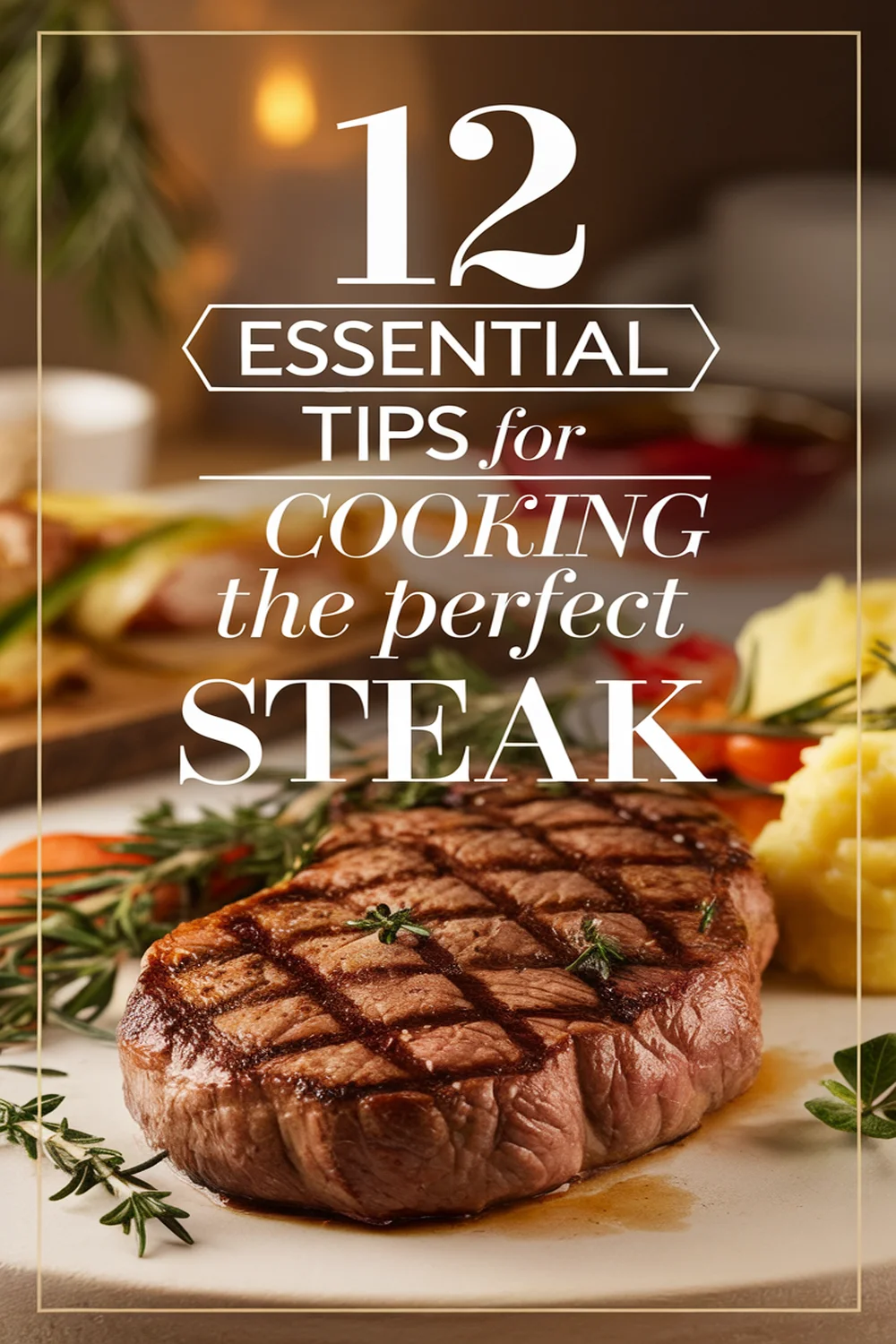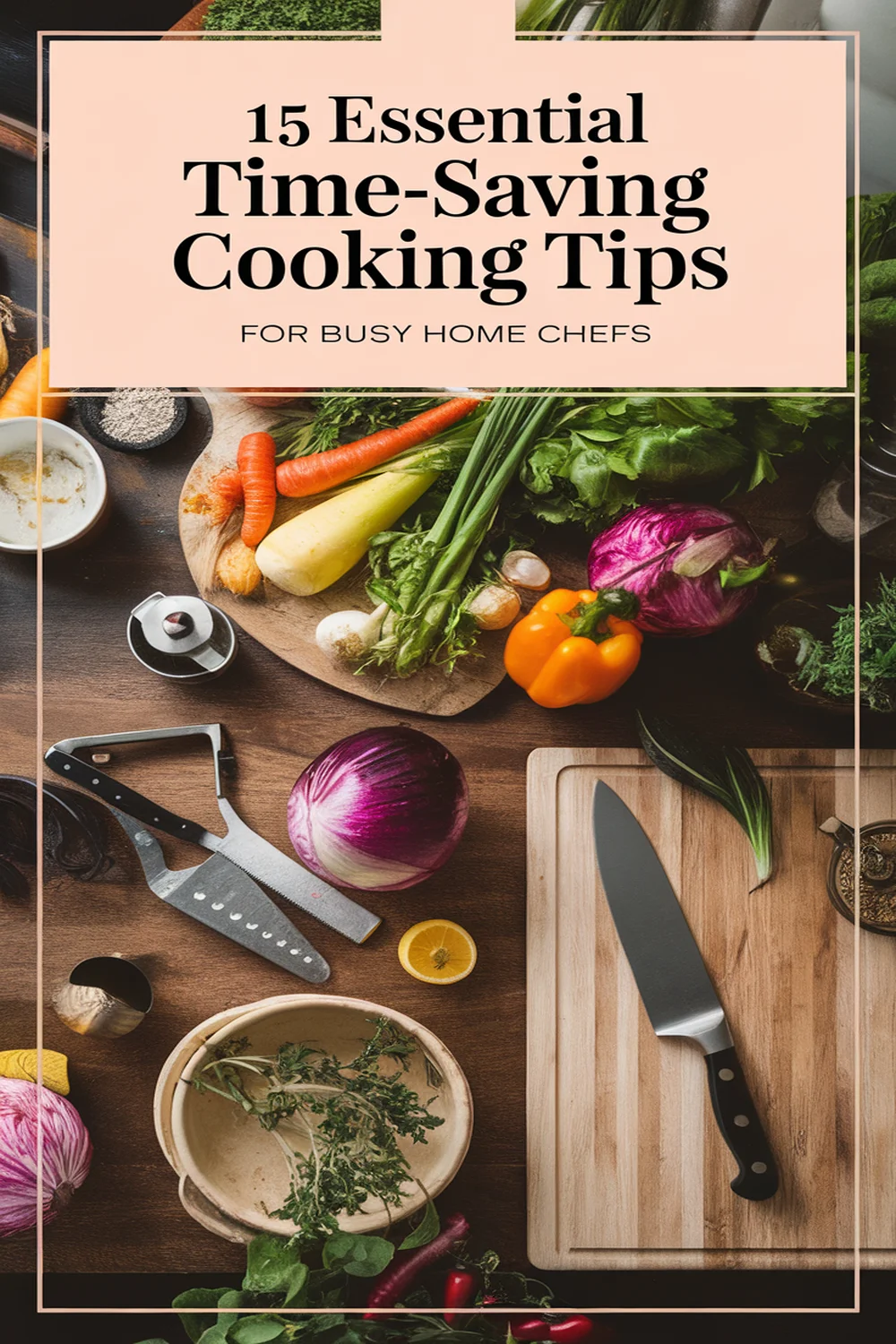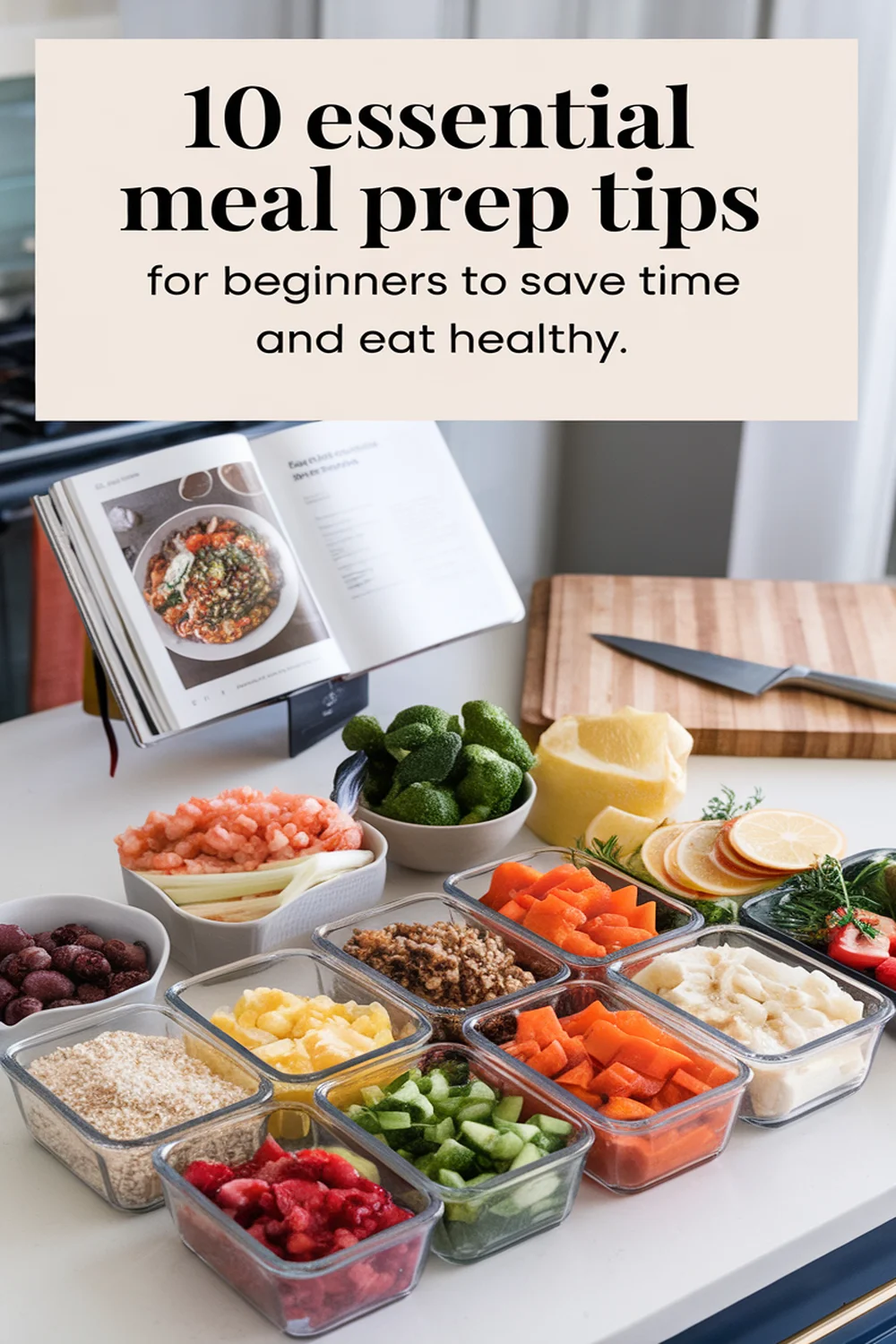This post may contain affiliate links. Please read our policy page.
To cook the perfect steak, start by choosing a quality cut like ribeye or filet mignon. Bring it to room temperature for even cooking and season generously with salt and pepper. Sear each side on high heat for caramelization, then let it rest to redistribute juices. Slice against the grain for tenderness. Don’t forget to experiment with marinades and upgrade your equipment for the best results. There’s plenty more to refine your steak cooking skills!
Choose the Right Cut of Meat
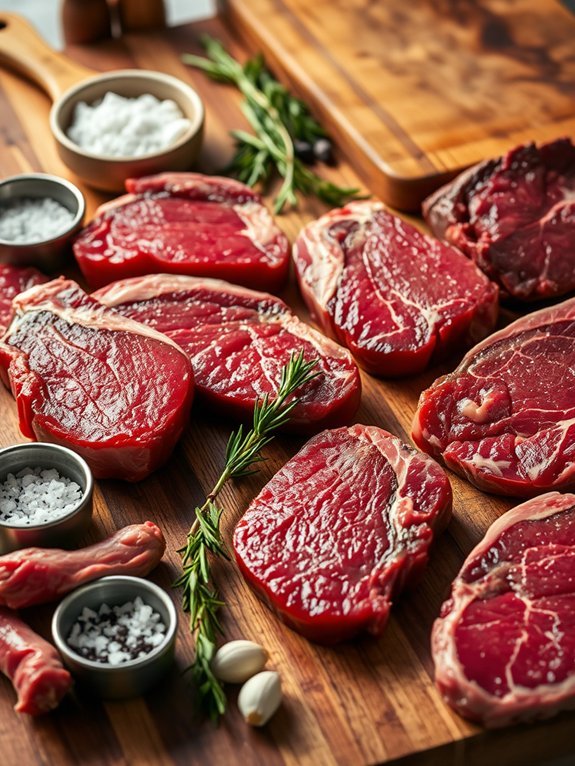
When it comes to cooking the perfect steak, the journey begins by choosing the right cut of meat. Each cut possesses unique textures and flavors that can dramatically influence the final dish. For those who prefer tender, melt-in-your-mouth experiences, cuts like filet mignon or ribeye are ideal, brimming with marbling that contributes to a luscious taste.
On the other hand, those looking for rich, beefy flavors may gravitate towards sirloin or flank steak, which, while leaner, can provide a satisfying chew and depth of taste.
Understanding the grades of meat is equally important. Look for USDA Prime for a superior experience, as this grade indicates the highest level of marbling and overall quality. However, if budget is a concern, USDA Choice offers excellent alternatives that can still yield delicious results.
Never underestimate the significance of freshness; always choose your steak from a reputable butcher or grocery store with high turnover to guarantee you’re getting a cut that will deliver on its promise of flavor.
- 1 steak (choose from ribeye, filet mignon, sirloin, or flank)
- Salt
- Freshly ground black pepper
- Optional: garlic powder, onion powder, or your favorite steak seasoning
- Olive oil or melted butter
Begin by allowing your steak to reach room temperature, letting it sit out for about 30 minutes. Preheat a cast-iron skillet or grill pan over high heat until it’s extremely hot. Lightly coat the surface with olive oil or melted butter.
Season both sides of your steak generously with salt and pepper (and additional seasonings, if desired). Once the pan is hot, place the steak in without overcrowding. Cook for about 3-5 minutes on each side, depending on thickness, for medium-rare, or adjust the time to reach your preferred doneness. Use a meat thermometer to check for doneness if unsure; aim for around 130°F for medium-rare.
For the best results, let your steak rest for about 5-10 minutes after cooking. This resting period allows the juices to redistribute throughout the meat, enhancing flavor and tenderness.
Additionally, for an even better steak experience, consider searing each side of the steak for a great crust before reducing the heat to cook it all the way through. Experimenting with different cuts will help you discover your favorite, and always remember that practice makes perfect when it comes to mastering steak cooking techniques.
Recommended Items
Ready to elevate your steak cooking game? Check out our top product and equipment recommendations!
Bring the Steak to Room Temperature
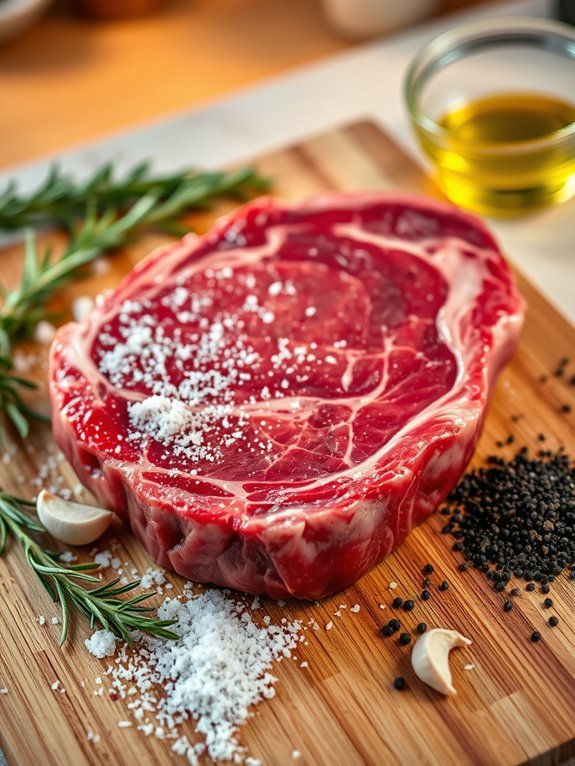
When it comes to cooking the perfect steak, one of the most vital steps is bringing your steak to room temperature before you cook it. This usually means allowing it to rest out of the fridge for about 30-60 minutes, depending on the thickness of the cut. This process helps to guarantee even cooking throughout the steak, resulting in a tender and juicy final product.
Cold meat straight from the fridge can lead to a seared exterior and a cold center, which isn’t ideal for steak enthusiasts.
While your steak is resting, this is also the perfect time to season it properly. Adding salt and pepper before it reaches the cooking stage allows the flavors to better penetrate the meat, enhancing the overall taste experience.
Remember to keep the steak uncovered while it rests to maintain air circulation and prevent it from stewing in its own juices. Now, you’re ready to move on to cooking!
- 1 steak (ribeye, sirloin, or your preferred cut)
- Salt (kosher or sea salt)
- Freshly ground black pepper
- Optional: garlic powder, onion powder, or other seasonings to taste
- Olive oil or butter (for cooking)
Take your steak out of the refrigerator and sprinkle both sides generously with salt and freshly ground black pepper. Let it sit at room temperature for 30-60 minutes before cooking to allow for even cooking and better flavor absorption.
Step-by-Step Cooking Guide
Season Generously
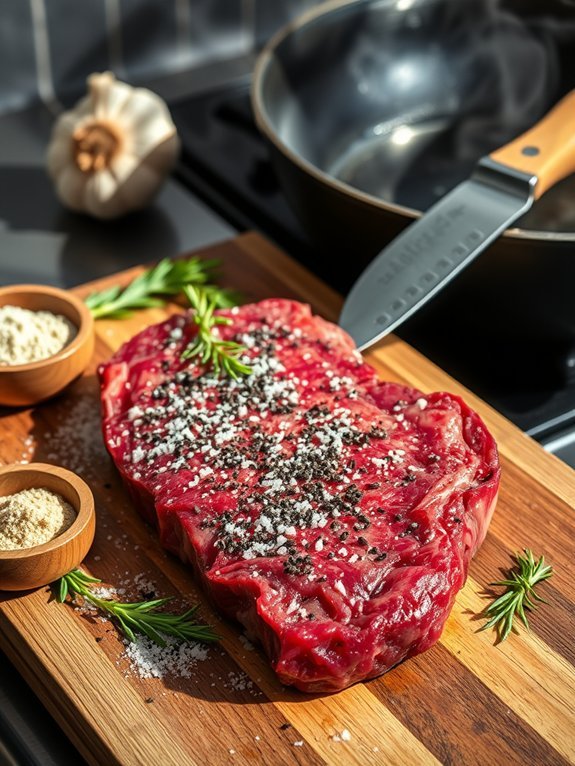
To achieve the perfectly seasoned steak, it’s crucial to understand the balance between flavor and texture. A well-seasoned steak not only enhances the natural taste of the meat but also creates a delicious crust that locks in juices.
It’s important to season the steak just before cooking, allowing the salt to penetrate the meat and improve its overall flavor profile. Use high-quality salt and freshly cracked black pepper to achieve the best results.
When seasoning, apply a generous amount of salt and pepper to both sides of the steak, and remember to let it rest for a few minutes after seasoning to allow the flavors to meld. Some chefs prefer to use additional seasonings such as garlic powder, onion powder, or herbs, depending on personal preference.
Ultimately, the key is to make the steak the star of the show, so choose your seasonings judiciously to complement instead of overpowering the natural flavors of the beef.
Ingredients:
- 1 ribeye steak (or your preferred cut)
- Kosher salt
- Freshly cracked black pepper
- Optional: garlic powder
- Optional: onion powder
- Optional: fresh herbs (e.g., thyme, rosemary)
Generously season both sides of the steak with kosher salt and freshly cracked black pepper, ensuring an even coating. If desired, sprinkle a dash of garlic powder and onion powder for additional flavor.
Allow the steak to sit at room temperature for about 30 minutes to further enhance the seasoning process. Preheat a cast-iron skillet or grill over high heat until it’s smoking hot, then place the steak on the cooking surface.
Cook for 4-6 minutes on each side for medium-rare, adjusting the cooking time according to your desired doneness.
For best results, always let your steak rest for a few minutes after cooking. This allows the juices to redistribute throughout the meat, ensuring a juicy and tender steak.
You can also consider using a meat thermometer to check for doneness accurately: 130°F for medium-rare and 140°F for medium. Additionally, feel free to finish your steak with a pat of butter or a sprinkle of fresh herbs to elevate the flavor even further, adding that finishing touch.
Use High Heat for Searing
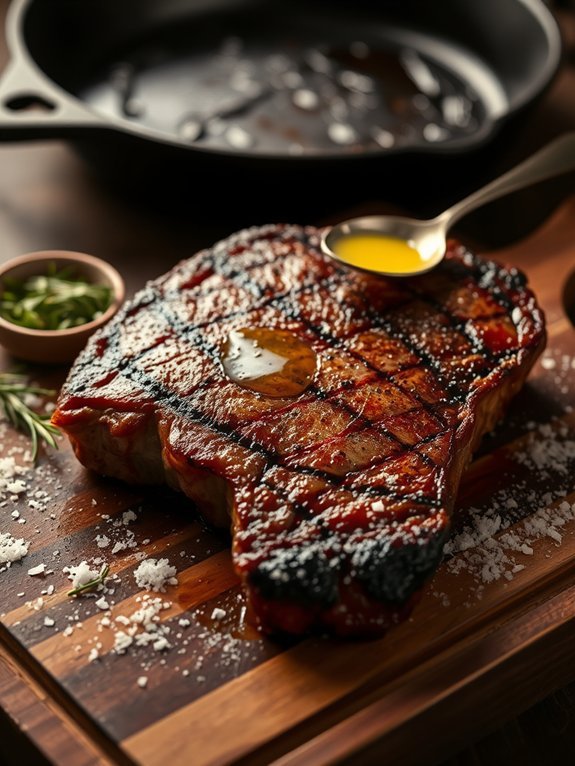
Cooking the perfect steak hinges on many factors, but one of the most important techniques is high heat searing. Searing creates a caramelized crust that locks in the juices and enhances the flavor of the meat. High temperatures not only provide that coveted rich browning but also help create a texture that contrasts beautifully with the tender interior of the steak. To achieve this, it’s vital to begin with a well-prepared piece of meat and a hot cooking surface.
Before you start cooking, confirm your steak is at room temperature. This helps it cook more evenly. Preheating your pan or grill to a high temperature is essential; it should be hot enough that you can easily feel the heat radiating from it. This high heat will help achieve perfect browning in just a few minutes on each side, creating not only visual appeal but also a deeply satisfying texture.
Ingredients:
- 1 ribeye or sirloin steak (about 1-inch thick)
- Kosher salt
- Freshly ground black pepper
- 1 tablespoon vegetable oil (or any high smoke point oil)
- Fresh herbs (optional: rosemary or thyme)
- 2 tablespoons unsalted butter (optional for basting)
Heat a heavy skillet, preferably cast iron, or your grill over high heat until it starts to smoke slightly. Pat your steak dry with paper towels, then season generously on both sides with kosher salt and freshly ground black pepper.
Once your pan is sizzling hot, add the vegetable oil, making sure it coats the bottom evenly. Carefully place the steak in the hot pan, let it sear for about 3-4 minutes without moving it, allowing for a golden crust to form. After the first side is well-browned, flip the steak using tongs and sear the other side for an additional 3-4 minutes, adjusting the timing based on your preferred level of doneness.
If desired, add butter and fresh herbs during the final minute of cooking, basting the steak for added flavor.
When cooking your steak, always allow it to rest for at least 5-10 minutes after removing it from the heat. This resting period allows the juices to redistribute throughout the meat, which guarantees a more flavorful and juicy bite.
Additionally, be careful not to overcrowd the pan if cooking multiple steaks; this can reduce the temperature of the cooking surface, resulting in steaming rather than searing. Finally, an instant-read thermometer can help avoid overcooking: aim for about 130°F for medium-rare.
Get the Perfect Grill Marks

Grilling the perfect steak is an art that many aspire to master, and achieving those coveted grill marks is vital to not only a visually appealing presentation but also a delicious, well-cooked piece of meat. The grill marks aren’t just for aesthetics; they enhance the flavor by allowing caramelization of the meat’s sugars and proteins. By following the right technique, you can impress your family and friends with a steak that has a beautiful char and scrumptious taste.
To get those perfect grill marks, the choice of steak, the marinade, and the grilling method are essential. First, select a steak with good marbling, such as ribeye or sirloin, as the fat content will keep it juicy and flavorful. After marinating or seasoning your steak, make certain your grill is preheated to a high temperature. This guarantees that your steak sears quickly, locking in moisture and creating those iconic crosshatch marks on the surface.
- 1 ribeye or sirloin steak (about 1 inch thick)
- Olive oil
- Salt
- Black pepper
- Optional marinade (soy sauce, Worcestershire sauce, garlic, or your favorite spices)
Preheat your grill to a high heat. Lightly brush the steak with olive oil on both sides, making sure it’s evenly coated. Season generously with salt and freshly ground black pepper (or your chosen marinade) and place the steak on the grill at a 45-degree angle to the grates.
Cook for about 2 to 3 minutes before rotating it 90 degrees to create the crosshatch pattern for another 2 to 3 minutes. Flip the steak and repeat the process on the other side, adjusting the time depending on your preferred doneness.
For even better results, always let your steak rest for about 5 minutes after grilling before cutting into it. This resting period allows the juices to redistribute throughout the meat, making it more tender and flavorful. Additionally, be sure to not overcrowd the grill; give each steak ample space to cook properly.
Finally, experimenting with different marinades and rubs can elevate your grilling game, providing various flavors that enhance the overall taste of the steak.
Flip Sparingly
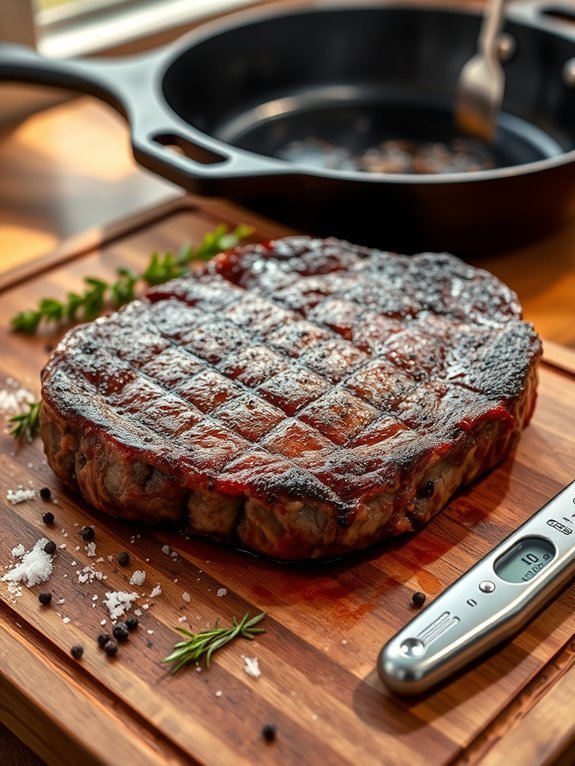
Cooking the perfect steak requires a good understanding of technique, and one of the most significant aspects is knowing when and how often to flip your meat. Flipping sparingly allows the steak to develop an incredible crust, which is vital for infusing flavor while keeping it juicy and tender. A common mistake many home cooks make is to flip their steak too often, disturbing the cooking process and preventing that delicious caramelization from forming.
When cooking a steak, patience is key. Start with a good-quality cut, seasoned simply with salt and pepper. Allow the steak to rest at room temperature for about 30 minutes before cooking to guarantee even cooking throughout. Use a cast-iron skillet or a well-seasoned grill to achieve the desired sear—this is where flipping sparingly comes into play.
Allow each side to cook undisturbed for several minutes before turning, enabling that perfect crust to form.
- 1 boneless ribeye or sirloin steak (1.5 inches thick)
- Kosher salt
- Freshly cracked black pepper
- 1 tablespoon vegetable oil or clarified butter
- Optional: fresh herbs (like thyme or rosemary) and garlic for flavoring
Preheat your skillet or grill to high heat. Season the steak generously with salt and pepper on both sides. Add the oil to the hot pan or grill, allowing it to shimmer but not smoke. Carefully place the steak in the pan or on the grill, and then resist the urge to touch it for 4-5 minutes, depending on your desired doneness.
After this initial searing time, flip the steak once using tongs, allowing it to cook for another 4-5 minutes without interruption. When cooking steak, consider using a meat thermometer to check for doneness—medium-rare typically centers around 135°F. Resting the steak after cooking is important; letting it rest for about 5-10 minutes allows the juices to redistribute throughout the meat, resulting in a tender, flavorful steak.
Additionally, make sure to cut against the grain when slicing, ensuring each bite is as enjoyable as the last. Don’t shy away from experimenting with different herbs and spices to enhance the flavor profile, but remember, less is often more with quality ingredients.
Use a Meat Thermometer
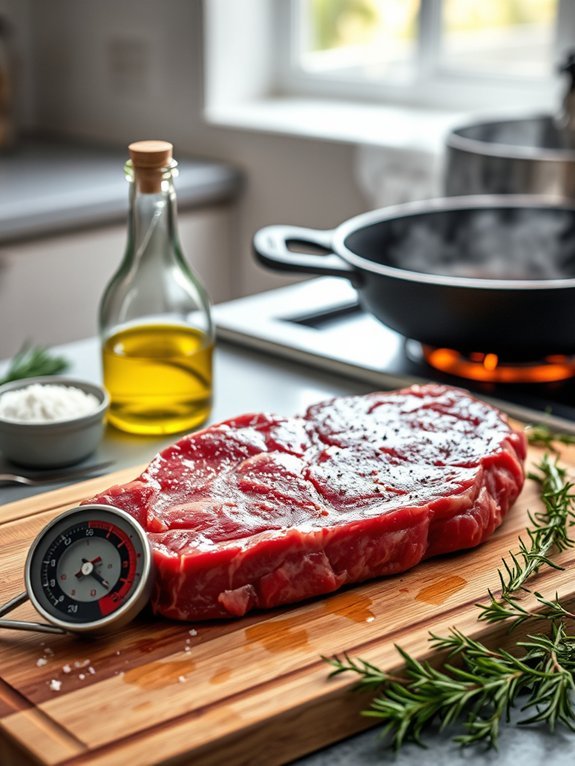
Cooking the perfect steak is an art that requires precision, and one of the most vital tools in achieving that perfection is a meat thermometer. Using this handy device takes the guesswork out of determining whether your steak is cooked to your desired level of doneness, guaranteeing juicy and tender results every time.
Whether you prefer your meat rare, medium, or well-done, a meat thermometer helps you reach that internal temperature just right, making it an indispensable tool in your kitchen arsenal.
Preparing a steak can seem straightforward, but to elevate your dish, understanding how temperature impacts the texture and flavor of the meat is essential. Before you even think about seasoning or cooking, you should allow your steak to come to room temperature, which promotes even cooking.
A meat thermometer won’t only help monitor the temperature but also prevent you from overcooking the steak, leading to an unappetizing, dry piece of meat. Follow the guidelines below to cook a steak that’s both flavorful and perfectly cooked.
- 1 thick-cut steak (ribeye, sirloin, or filet mignon)
- Salt (kosher or sea salt)
- Freshly ground black pepper
- Olive oil or butter
- Optional: garlic cloves, fresh herbs (like rosemary or thyme)
To cook your steak, begin by preheating your grill or cast-iron skillet over medium-high heat. Pat the steak dry with paper towels, then rub a light layer of olive oil on both sides. Season generously with salt and pepper.
When the grill or skillet is hot, place your steak on it and sear for about 4-5 minutes on one side, without moving it, to develop a beautiful crust. Flip the steak and begin checking the internal temperature with your meat thermometer at approximately 3-4 minutes later.
For rare, look for 130°F; for medium-rare, aim for 135°F; for medium, go for 145°F; and for well-done, wait until it reaches 160°F. Once done, let it rest for 5-10 minutes before slicing.
When cooking a steak, always remember to let it rest after cooking. This step is often overlooked but is vital for retaining juices. Allowing the meat to rest redistributes the juices inside the steak, which can otherwise escape when cut; this keeps your steak moist and flavorful.
Additionally, invest in a reliable instant-read meat thermometer to guarantee accuracy, as different cuts and thicknesses may require varying cooking times. Finally, don’t hesitate to experiment with marinades or seasoning blends to enhance the flavor profile of your steak.
Baste for Extra Flavor
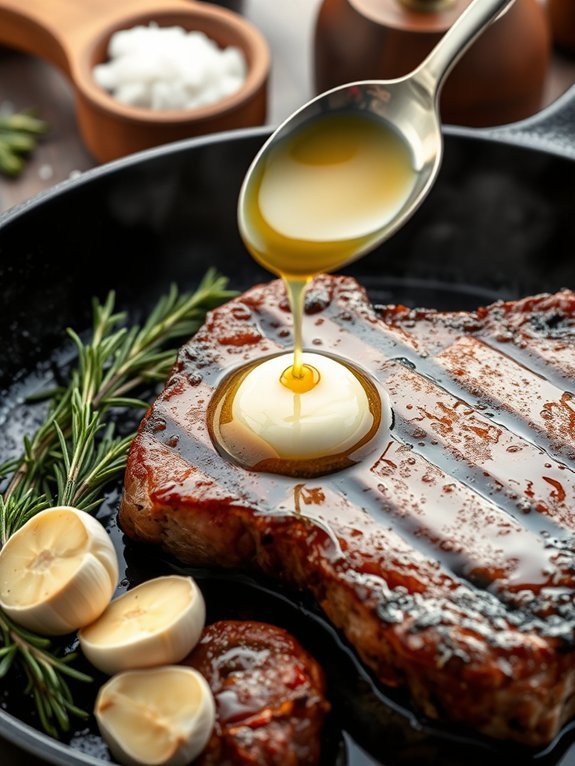
Basting is an essential technique that elevates the flavor and juiciness of a steak, transforming a simple cut of meat into a gourmet experience. By spooning fat, often infused with aromatics, over the cooking steak, you infuse it with rich flavors while simultaneously keeping it moist. This technique is especially effective when cooking a thicker steak, as it allows the exterior to crisp up beautifully while the interior remains tender and flavorful.
To achieve the perfect baste when cooking your steak, it’s important not to go overboard with the seasoning. Instead, focus on using high-quality fats, such as butter or oil, combined with herbs and garlic. This careful balance enhances the steak’s natural flavor without overwhelming it. As you cook, you’ll notice how basting creates a glossy, beautiful finish that’s absolutely enticing.
Ingredients:
- 1 thick-cut steak (ribeye, New York strip, or filet mignon)
- Salt and black pepper
- 3 tablespoons unsalted butter
- 2 cloves garlic, smashed
- Fresh herbs (such as thyme or rosemary)
- Olive oil (optional)
When you’re ready to cook, season the steak generously with salt and pepper and let it come to room temperature for about 30 minutes. Heat a cast-iron skillet or heavy pan over high heat until it’s almost smoking, then add a splash of olive oil if desired.
Sear the steak on one side for 3-5 minutes until a crust forms, then flip it. Immediately add the butter, garlic, and herbs to the pan. As the butter melts, spoon it over the steak repeatedly for an additional 3-5 minutes, or until the steak reaches your desired doneness.
One important tip to remember while basting is to control the heat. If the pan becomes too hot, the butter can burn, imparting a bitter taste to the steak. Additionally, invest in a good meat thermometer to ascertain perfect doneness.
Allow the steak to rest for at least 5-10 minutes after cooking to let the juices redistribute, guaranteeing that each bite is tender and juicy. Finally, don’t hesitate to experiment with different herb combinations or aromatics to customize the flavor of your basting mix!
Let It Rest

After cooking a steak to your desired doneness, the next vital step is allowing it to rest. This process is essential as it helps the juices redistribute throughout the meat, resulting in a more flavorful and tender steak.
When you cut into a steak right after cooking, the juices haven’t had the chance to settle, which can lead to a dry and less enjoyable eating experience. Resting the steak for a specified time will greatly enhance the overall texture and moisture level.
To rest your steak properly, transfer it to a cutting board and loosely cover it with aluminum foil. This will help keep the steak warm while allowing the surface moisture to evaporate, preventing it from becoming soggy.
The recommended resting time typically ranges from 5 to 10 minutes, depending on the size and thickness of the steak. During this period, you can use the time to prepare sides or sauces for your meal.
- Steak (your choice of cut: ribeye, sirloin, filet mignon, etc.)
- Salt
- Pepper
- Olive oil or butter
- Optional: fresh herbs (such as rosemary or thyme), garlic
Once your steak is cooked to your liking and removed from the heat, place it on a cutting board and loosely tent it with aluminum foil.
Allow it to rest for about 5 to 10 minutes to guarantee that the juices redistribute properly throughout the meat before cutting into it.
When resting your steak, remember that the internal temperature will continue to rise a few degrees even after it’s off the heat.
So, take this into consideration when cooking to avoid overcooking. Also, try to avoid cutting into it before it has finished resting; this can cause the delicious juices to escape, resulting in a less juicy steak.
Finally, using a meat thermometer can help you achieve the perfect doneness every time.
Slice Against the Grain
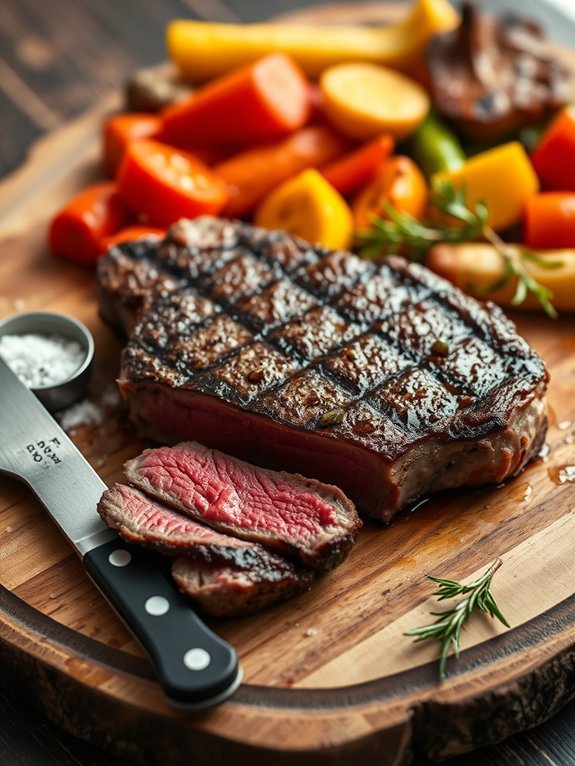
When it comes to enjoying a perfectly cooked steak, how you slice it can greatly impact the overall experience. Slicing against the grain is vital as it shortens the muscle fibers, making each bite tender and easier to chew. Understanding how to identify the grain and slice correctly will elevate your steak dining experience, whether you’re grilling a ribeye, sirloin, or filet mignon.
First, allow the steak to rest for about 5 to 10 minutes after cooking. Resting is key because it allows the juices to redistribute throughout the meat, preventing them from running out when you make the first cut.
Once rested, place the steak on a cutting board and look for the direction of the muscle fibers – this is the grain. Remember, the goal is to cut perpendicular to this direction.
- 1 perfectly cooked steak (any cut of choice)
- Salt (for seasoning)
- Freshly ground black pepper (for seasoning)
- Optional: garlic powder or other seasonings of choice
- A sharp knife
- A sturdy cutting board
To slice the steak, first make sure your knife is sharp to provide clean cuts. Turn the steak so that the grain is facing you, and begin slicing across the grain at a 45-degree angle. Aim for slices about half an inch thick for the best texture. Serve immediately, making sure each slice showcases the juicy, tender interior of the steak.
Keep in mind that resting your steak is just as important as the cooking process itself. If you slice the steak too soon, you may lose the juices, resulting in a drier meal.
Also, experimenting with the angle and thickness of your slices can help you discover the perfect bite. Pair your steak with a side dish that complements it well, such as roasted vegetables or a fresh salad, to enhance your dining experience.
Experiment With Marinades
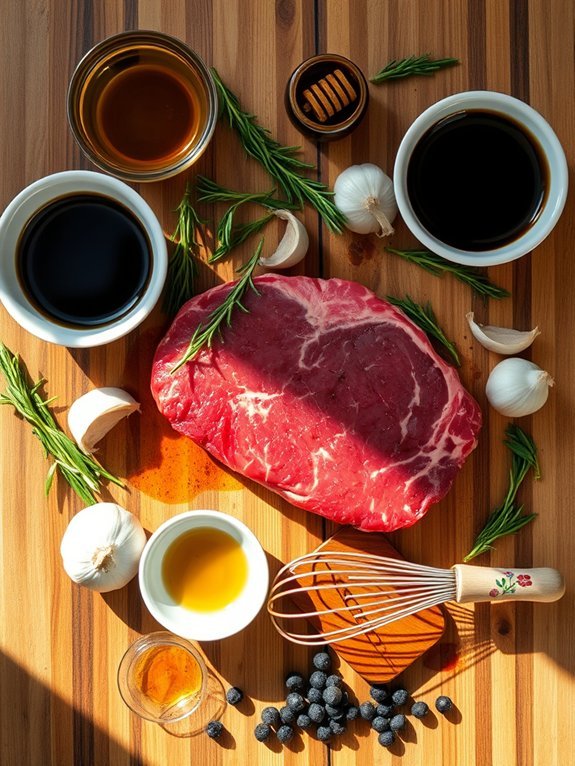
When it comes to cooking the perfect steak, one of the most delightful techniques to enhance flavor and tenderness is experimenting with marinades. Marinades can introduce a myriad of flavors depending on the ingredients you choose, and they also help to break down tough fibers in the meat, making your steak not only tastier but also more enjoyable to eat.
Allowing your steak to soak in a thoughtful marinade for several hours or overnight can transform an ordinary cut of beef into a sensational meal that leaves an impression on everyone at your dinner table.
Creating a marinade is simple, and it’s an opportunity to get creative in the kitchen. Common marinade components include an acid (like vinegar or citrus juice), oil, herbs, and spices, but feel free to personalize your blend based on your taste preferences.
For this recipe, you’ll be marinating your steak in a savory mixture that soaks deep into the meat, preparing it for a quick and satisfying cook on the grill or stovetop.
Ingredients:
- 1 pound of steak (ribeye, sirloin, or flank)
- ¼ cup olive oil
- ¼ cup soy sauce
- 2 tablespoons balsamic vinegar
- 2 tablespoons honey
- 3 cloves garlic, minced
- 1 tablespoon Dijon mustard
- 1 teaspoon black pepper
- 1 teaspoon dried rosemary or thyme
Pour all the marinade ingredients into a mixing bowl and whisk until well combined. Place your steak in a resealable plastic bag or a shallow dish and pour the marinade over it, making sure that the steak is well coated.
Seal the bag or cover the dish and refrigerate for at least 2 hours, or ideally overnight for maximum flavor. When ready to cook, remove the steak from the marinade and let it sit at room temperature for about 30 minutes before grilling or pan-searing it to guarantee even cooking.
Cook the steak to your desired level of doneness, around 4-6 minutes per side for medium-rare, depending on the thickness.
When experimenting with marinades, don’t hesitate to tweak the ingredients to suit your palate. Adding different herbs, spices, or even fruit purees can create unique flavor profiles that will make each steak memorable.
Additionally, remember to not reuse marinades that have come into contact with raw meat unless they’re boiled first, as this helps to eliminate any harmful bacteria.
Finally, after cooking, always let your steak rest for 5-10 minutes before slicing—this helps the juices redistribute for a juicier, more flavorful bite. Enjoy your culinary adventure!
Upgrade Your Cooking Equipment

When it comes to cooking the perfect steak, having the right equipment is just as important as knowing the right techniques. Upgrading your cooking tools can dramatically enhance the quality of your steak by providing more consistent heat, better searing capabilities, and ease of use.
Whether it’s a premium cast iron skillet, a high-quality grill, or even a sous vide immersion circulator, investing in superior cooking equipment will give you more control over your steak‘s doneness and texture.
A cast iron skillet is ideal for stovetop cooking because it retains heat exceptionally well, allowing you to achieve that mouthwatering crust on the outside while maintaining a juicy center. Similarly, a proper grill won’t only add flavor but also create the ideal sear marks that elevate the visual appeal of your steak.
To take your steak cooking to the next level, don’t forget tools like a good meat thermometer to verify perfect doneness, and high-quality tongs to maneuver your steak without piercing the surface.
Ingredients:
- 2 ribeye or sirloin steaks (1 inch thick)
- Salt
- Freshly ground black pepper
- 1 tablespoon olive oil or vegetable oil
- 2 tablespoons unsalted butter
- Fresh herbs (like thyme or rosemary) for basting (optional)
- Garlic cloves (optional)
Heat your cast iron skillet over medium-high heat for about 5 minutes until it’s very hot. Generously season both sides of the steaks with salt and pepper.
Once the skillet is hot, add the oil and swirl it around to coat the pan. Carefully place the steaks in the skillet, searing each side for about 2-3 minutes without moving them. For extra flavor, add butter, herbs, and garlic to the pan, basting the steak with the melted butter as they cook for another 3-4 minutes, or until they reach your desired doneness.
Use a meat thermometer to check for doneness: 130°F for medium-rare, 140°F for medium.
When cooking steak, remember that resting is just as critical as cooking. After achieving the desired temperature, remove the steak from the skillet and let it rest for 5-10 minutes under a loose foil tent.
This resting time allows the juices to redistribute throughout the meat, verifying every bite is juicy and flavorful. Additionally, keep in mind that steak will continue to cook slightly while it rests due to residual heat, so remove it from the heat just before it reaches your target temperature.

